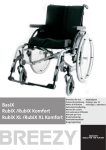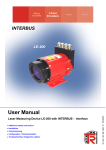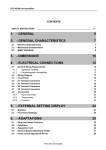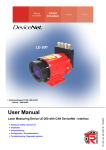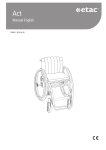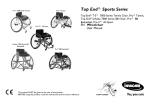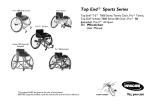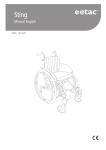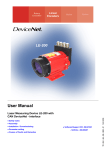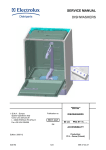Download Argon UK_F_I_ES_P - Wheelchair Review
Transcript
First time, second time, everytime Directions for use Notice D’Utilisation Manual De Usario Manuale Per l’Uso Instruções para Utilização Dear Customer, We are very happy that you have decided in favour of a high-quality product from SUNRISE MEDICAL. This user’s manual will provide numerous tips and ideas so that your new wheelchair can become a trustworthy and reliable partner in your life. Maintaining close links with our customers is of great importance to us at Sunrise Medical. We would therefore like to keep you upto-date with our new and current developments. Keeping close to our customers also means fast service when you need replacement parts or accessories, or just have a question about your wheelchair — and with as little red tape as possible. We want you to be satisfied with our products and service. Sunrise Medical therefore constantly works at continuous development of its products. For this reason, changes can occur in our range of products with regard to shape, technology, and fittings. Consequently, no claims can be construed from the data or pictures contained in this user’s manual. SUNRISE MEDICAL has been awarded the ISO 9001 Certificate, which affirms the quality of our products at every stage, from R & D to production. Please contact your local, authorised SUNRISE MEDICAL dealer if you have any questions concerning the use, maintenance, or safety of your wheelchair. In the case that there is no authorised dealer in your area or you have any questions, you can contact Sunrise Medical either in writing or by telephone (contacts are mentioned on the last page). Sunrise Medical Ltd. Sunrise Business Park High Street, Wollaston West Midlands DY8 4PS England Telephone: +44/1384-446622 Fax: +44/1384-446644 www.sunrisemedical.com Table of contents Foreword for Wheelchairs Safety Tips for Wheelchairs . . . . . . . . . . . . . . . . . . . . . . . . . . . . . . .4 Wheelchair Components . . . . . . . . . . . . . . . . . . . . . . . . . . . . . . . . .5 Handling Folding Up and Unfolding . . . . . . . . . . . . . . . . . . . . . . . . . . . . . . . .6 Options Step Tubes . . . . . . . . . . . . . . . . . . . . . . . . . . . . . . . . . . . . . . . . . . .6 Wheel Locks . . . . . . . . . . . . . . . . . . . . . . . . . . . . . . . . . . . . . . . . . .6 Suspension system . . . . . . . . . . . . . . . . . . . . . . . . . . . . . . . . . . . . .6 Footplate Adjustment . . . . . . . . . . . . . . . . . . . . . . . . . . . . . . . . . . .7 Castor . . . . . . . . . . . . . . . . . . . . . . . . . . . . . . . . . . . . . . . . . . . . . . .7 Seat . . . . . . . . . . . . . . . . . . . . . . . . . . . . . . . . . . . . . . . . . . . . . . . . .7 Castor . . . . . . . . . . . . . . . . . . . . . . . . . . . . . . . . . . . . . . . . . . . . . . .7 Seat height . . . . . . . . . . . . . . . . . . . . . . . . . . . . . . . . . . . . . . . . . . .8 Wheel Alignment . . . . . . . . . . . . . . . . . . . . . . . . . . . . . . . . . . . . . . .8 Back . . . . . . . . . . . . . . . . . . . . . . . . . . . . . . . . . . . . . . . . . . . . . . . .9 Backrest . . . . . . . . . . . . . . . . . . . . . . . . . . . . . . . . . . . . . . . . . . . .10 Lap belt instructions . . . . . . . . . . . . . . . . . . . . . . . . . . . . . . . . . . .10 Anti-Tip Tubes . . . . . . . . . . . . . . . . . . . . . . . . . . . . . . . . . . . . . . . .11 Seat . . . . . . . . . . . . . . . . . . . . . . . . . . . . . . . . . . . . . . . . . . . . . . . .11 Seat Depth . . . . . . . . . . . . . . . . . . . . . . . . . . . . . . . . . . . . . . . . . .11 Crutch Holder . . . . . . . . . . . . . . . . . . . . . . . . . . . . . . . . . . . . . . . .11 Travel Wheels . . . . . . . . . . . . . . . . . . . . . . . . . . . . . . . . . . . . . . . .11 Tyres and Mounting . . . . . . . . . . . . . . . . . . . . . . . . . . . . . . . . . . . .11 Trouble Shooting . . . . . . . . . . . . . . . . . . . . . . . . . . . . . . . . . . . . . .12 Maintenance and Care . . . . . . . . . . . . . . . . . . . . . . . . . . . . . . . . .12 Technical Data . . . . . . . . . . . . . . . . . . . . . . . . . . . . . . . . . . . . .12-13 Nameplates/Guarantee . . . . . . . . . . . . . . . . . . . . . . . . . . . . . . . . .13 Torque . . . . . . . . . . . . . . . . . . . . . . . . . . . . . . . . . . . . . . . . . . . . . .13 This manual gives information on all features sold across different countries, without stating whether they are actually available in your country or are optional or standard features. For this information please refer to the orderform/prescription form or your prescriber/supplier. 0505/2/ST-000690644.EMS 1B ARGON 3 ENGLISH Foreword (1.1.1) ENGLISH Safety Tips(3.2) The engineering and construction of this wheelchair have been designed to provide maximum safety. International safety standards currently in force have either been fulfilled or exceeded. Nevertheless, users may put themselves at risk by improperly using their wheelchairs. For your own safety, the following rules must absolutely be observed. Unprofessional or erroneous adaptation or adjustment work could increase the risk of accidents. As a wheelchair user, you are also part of the daily traffic on streets and sidewalks, just like anyone else. We would like to remind you that you are thus also subject to any and all traffic laws. For this reason, you should always wear light clothing in the dark as much as possible so that you can be seen more easily and make sure that the reflectors are not covered. Be careful during your first ride in this wheelchair. Get to know your wheelchair. Test what effect changing the center of gravity would have on your wheelchair. Practice using your wheelchair on level ground as well as going uphill and downhill. CAUTION: The wheel locks are not intended to brake your wheelchair. They are only there to ensure that your wheelchair does not begin rolling unintentionally. When you stop on uneven ground, you should always use the wheel locks to prevent such rolling. Always set both wheel locks; otherwise, your wheelchair could tip over. The wheel locks have not been designed to be used as brakes for a moving wheelchair. Always make use of elevators and ramps. If these are not available, you can reach your destination with the aid of two attendants. They should grip the wheelchair at securely mounted parts. If your wheelchair is equipped with anti-tip tubes, these should be folded away. A wheelchair should never be lifted with an occupant; it should only be pushed. Before each use, the following should be checked: • Quick-release axles on the rear wheels • Velcro on seats and backrests • Tyres, tyre pressure, and wheel locks. Wheel locks will not function properly if tyre pressure is too low or the interval between tyres and wheel locks is too large. The maximum user weight is 120 kilograms. This wheelchair should be used exclusively to convey one person at a time in the seat. Any other use beyond this limit is in violation of safety regulations. Users should not sit in the wheelchair while riding in any and all means of transportation. Only permanently installed seats and seat belts will offer sufficient protection in hazardous situations. When vehicles are in motion, unoccupied wheelchairs should be secured using appropriate means. Before changing any of the adjustments of this wheelchair, it is important to read the corresponding section of the user’s manual. It is possible that potholes or uneven ground could cause this wheelchair to tip over, especially when riding uphill or downhill. When riding over a step or up an incline frontally, the body should be leaning forward. 4 ARGON 0505/2/ST-000690644.EMS 1B Wheelchair Components (4.1) ENGLISH We at SUNRISE MEDICAL have been awarded the ISO 9001 Certificate, which affirms the quality of our products at every stage, from R & D to production. This product complies with the standards set forth in EU directives. Optional equipment and accessories are available at extra charge. Wheelchairs: 1. Push handles 2. Backrest upholstery 3. Sideguards 4. Seat sling 5. Footrest 6. Castors 7. Castor plates 8. Fork (6“ castor) 9. Quick-release axles 10. Wheel locks 11. Handrim 12. Rear wheel 2 1 3 4 9 10 6 11 12 5 8 0505/2/ST-000690644.EMS 1B 7 ARGON 5 The wheel locks have not been designed to be used as brakes for a moving wheelchair. The wheel locks should therefore never be used to brake a moving wheelchair. Always use the handrims for braking. Make sure that the interval between the tyres and wheel locks complies with given specifications. To readjust, loosen screw (1) and set the appropriate interval. Tighten screw (see the page on torque) ENGLISH Handling Quick-Release Axles for Rear Wheels (6.2) The rear wheels are equipped with quick-release axles. The wheels can thus be installed or removed without using tools. To remove a wheel, simply depress the quickrelease button on the axle (1) and pull it out. 1 CAUTION: Hold the quick-release button on the axle depressed when inserting the axle into the frame to mount the rear wheels. Release the button to lock the wheel in place. The quick-release button should snap back to its original position. 1 3 mm 1 CAUTION: After each adjustment of the 520 rear wheels, check the interval to the wheel locks and readjust if necessary. Extension for the wheel lock Lever (7.11) Transporting the chair The extension for the wheel lock lever can be removed or folded down. The longer lever helps to minimize the effort needed to set the wheel locks. Transporting the chair (6.5) Removing the rear wheels will keep the chair as compact as possible. The backrest can be folded down by pulling the cord located on the backrest. Caution: Mounting the wheel lock too close toward the wheel will result in a higher effort to operate. This 521 might cause the wheel lock extension lever to break! 503 Leaning onto the wheel lock extension lever while transferring will cause the lever to break! Splashing water from tyres might cause the wheel lock to malfunction. Options – Suspension system 514 Suspension system (7.17) The function of the suspension system is determined by the buffer elements (1). Sunrise Medical offers a varied range of elements to suit the individual weight of the user. Step Tubes Step Tubes (7.1) Step tubes are used by attendants to tip a wheelchair over an obstacle. Simply step on the tube to push a wheelchair, for example, over a kerb or step. To replace the elements, remove the 2 screws (2) (1 on each side). Turn the rocker arms (3) downwards; the buffer elements (1) can then be easily removed from the upper and lower openings. 519 522 To fit new sleeves, use the reverse procedure. Ensure that the buffer elements are securely located in the upper or lower openings. Options – Wheel Locks Wheel Locks (7.10) Your wheelchair is equipped with two wheel locks. They are applied directly against the tyres. To engage, press both wheel-lock levers forward against the stops. To release the wheel, pull the levers back to their original positions. Braking power will decrease with: • Worn tyre tread • Tyre pressure that is too low • Wet tyres • Improperly adjusted wheel locks. 520 6 ARGON 0505/2/ST-000690644.EMS 1B Options – Seat Adjusting the seat height (7.53.2) Divided and Platform Footplates (7.22) 4 To adjust rear seat height, slacken and remove the 4 Torx screws (1) (2 each side) and the thread washer (2), which secures the clamp (3) for the camber tubes to the axle plates (4). Adjust the two camber tube clamps (3) to the required height and replace the 4 Torx screws. Before tightening the screws, please follow the instructions for setting the toe-in/toe-out to zero (section 7.61.1). Footplates can be flipped up to facilitate getting in and getting out of your wheelchair. They can also be tilted to six different angles relative to a level surface. Tighten screw (1) firmly on the outer side. By removing the clips 1 (2), the footplate can be adjusted 15.1 to three different positions toward both the front and rear. Loosen the adjustment screw (3) to change the horizontal position of the footplate. For this purpose, the footplate must be flipped up. When finished, make sure that all screws have been properly tightened (see the page on torque). A minimum interval of 2.5 centimeters from the ground should always be maintained. 2 Tighten the screws to 7 Nm. ENGLISH Options – Footplate Adjustment 1 2 3 508 NOTE – An adjustment to the castor angle may be necessary when adjusting the rear seat height. Options – Castor Adjusting the castor (7.42.3) 15.2 To ensure that both forks are set parallel, simply count the teeth visible on both sides. After setting the castor fork, the teeth will guarantee a secure position, allowing an adjustment of 16° in 2° increments. Use the flat side to check for a right-angled position to the ground. 3 15.3 The patented design allows the castor fork to be turned, so that it can be reset at rightangles to the ground when the seat angle is changed. 191 Adjusting the Footrest (7.25) Removing screw (1) will allow you to adjust the footrest to correspond to the length of your lower leg. The angle of the footrest may be individually adjusted (not rigid footrest) by loosening nuts (2). The footrest bracket (3) prevents feet from unintentionally slipping out place. When finished, make sure that all screws have been properly tightened (see the page on torque). 1 +8° -8° 2 523 524 525 526 195 Options – Castor Castors, Castor Plates, Forks (7.40) From time to time the wheelchair may veer slightly to the right or left, or the castors may flutter. This may be caused by the following: • Forward and/or reverse wheel motion has not been set properly. • The castor angle has not been adjusted properly. • Castor and/or rear wheel air pressure is incorrect; wheels do not turn smoothly. The wheelchair will not move in a straight line if the castors have not been properly adjusted. Castors should always be adjusted by an authorized dealer. The castor plates must be readjusted, and the wheel locks must be checked any time the rear wheel position has been altered. 0505/2/ST-000690644.EMS 1B ARGON 7 Argon tracking adjustment (7.61.1) Options – Seat height ENGLISH 3. Setting the toe-in/toe-out to zero Adjusting front seat height (Adjustable frame) (7.53.2) NOTE: On a wheelchair with 0° camber cylinders it is not possible to set toe-in or toe-out. This setting is necessary only with 3°, 6° and 9° camber cylinders. 1. Slacken the screw (1) and remove the cover (2). This releases the height adjustment fixing. 2. By turning the castor connection you can continuously adjust the seat height by +/- 1.5 cm. 1 2 3 Using the marking (3) on the castor connection, you can ensure that both castors are set the same. 3. Ensure that both castors are set at the same height, otherwise the chair cannot move in a straight line. The term “toe-in or toe-out” defines how well the rear wheels of the chair are aligned in relation to the ground. This determines how well the chair will run. Normal resistance or rolling resistance is provided, when toe-in is set to zero. 508 To set toe-in/toe-out to zero: Slacken the 2 Torx screws (1) (1 each side) which secure the angle tube clamp. Check the ball in the horizontal (2) plane and turn the angle tube (3) until the ball is in the centre. 4. Ensure that the bolts (4) always face outwards and are at right-angles to the direction of travel, so that it will move in a straight line. 5. Replacing the cover (2) and tightening the screw (1) secures the height adjustment fixing. When doing this, be careful to observe the starting torque. Toe-in is now zero. Before tightening screws (1), check that the camber tube is centred left-toright. The gap should be the same on both sides, or there should be no gap at all. Tighten the screws to 7 Nm. Adjusting the directional stability 1. Slacken the screw (1) and remove the cover (2). This releases the height adjustment fixing. 1 2. Bring the castor fork at right-angles to the direction of travel and put a set-square onto the straight surface (3) of the fork. 2 527 3 3 3. By turning the castor connection, the castor can be turned inwards or outwards to correct directional stability. 4. Replacing the cover (2) and tightening the screw (1) secures the height adjustment fixing. When doing this, be careful to observe the starting torque. 1 2 528 525 Width adjustment of the wheelbase (7.62) 6 K. REAR WHEELBASE Options – Wheel Alignment Adjusting Wheel Alignment (7.61) Important: Your chair will only roll properly if the rear wheel positions have been optimized, which means correctly adjusting the wheel alignment. To do this, measure [the distance between] both wheels front and rear to ensure that they are parallel to one another. The difference between both measurements should not exceed 5 mm. To adjust the wheels to make them parallel, loosen the screws and turn the axle sleeve accordingly. When finished, make sure that all screws have been properly tightened (see the page on torque). The rear wheelbase is defined as the distance between the upper side of the rear wheels and the backrest tubes, and is represented by measurement. The factory setting is (1.25 cm). A bigger gap is usually required when a sufficient gap between the tyres and optionally height-adjustable armrests has to be created. NOTE: When adjusting the rear wheelbase, adjust first one wheel then the other. 5 4 508 If both sides are slackened at the same time, the adjustment of toe-in/toe-out will be altered. To adjust the rear wheelbase, the parts of the camber (4) move telescopically into or out of the camber tube (5), and lock into place when they reach the end. Slacken screw (6) (located closest to the camber tube) on the left side of the chair. Move the quick-release axle inwards or outwards to achieve the desired wheelbase. Tighten the screws to 7 Nm. Repeat this procedure on the right side of the chair and adjust the gap so that it is the same amount as on the left side. 8 ARGON 0505/2/ST-000690644.EMS 1B Options – Armrest Angle-adjustable rigid back (7.77.1.1) Quickie – height adjustable armrest (7.81.4 ) The backrest angle is adjusted by the interlocking teeth of the backrest cylinder (1) and the backrest mounting (B). To adjust the angle, insert a Torx T40 key (2) into the slit in the backrest tube (3), and release the screws (4) on both sides of the chair, until the teeth are free and can be adjusted. 1. Fitting a. Push the outside armrest support into the clamp which is mounted on the chair frame. b. The armrest will automatically lock into place. 2 4 1 Adjust the backrest tubes on the left side of the chair to achieve the required angle to the chair frame, and tighten the screw (4) to 24 Nm. Use the Allen key extension. 536 2. Height adjustment a. Turn the release lever to the second position. b. Push the arm support up or down to the required height. c. Turn the release lever back to the armrest locking position. d. Push the arm support in until the upper armrest locks into position. 3. Removing the armrest a. Turn the release lever to the first position and remove the armrest. Note the position markers on the backrest cylinder (A) and the backrest mounting (1) on the left of the chair, and adjust the right side to the same position. Tighten the screws to 24 Nm. 4 3 Adjustable back sling (7.77.2) 4. Changing the armrest a. Push the armrest back into the clamp. b. Turn the release lever back to the armrest locking position. 5. Adjusting the fit of the armrest receiver To tighten or slacken the fit of the outside armrest in the clamp: a. Release the four bolts on the sides of the clamp. b. Hold the armrest in the clamp and squeeze the clamp together at the required fit. c. Tighten up the four bolts. 6. Adjusting the fit of the inner armrest a. The outside armrest is fitted with two stud bolts. b. Turn stud bolts in or out as required until you have found the desired fit. The adjustable back-sling can be adjusted for tension by using several straps. The back-sling upholstery can be accessed from the inside via an opening and can be upholstered to suit individual tastes 529 Height adjustable backrest (7.77) The backrest height can be adjusted to 5 different positions (38–48 cm). Open and remove the bolt (1) and move the back tube into the desired position. Then fix the bolt again. 1 506 516 Standard sideguard, flip-up, removable with short or long arm pads (7.81.3) With the sideguard which is stepped down at the front it is possible to move up closer to a table. To flip them up press the lever (G) forwards, so that the sideguard is released. ATTENTION! Sideguards, and the armrests are not designed to be used to lift or carry the wheelchair. 530 Sideguard, flip-up, removable with short or long arm pads, height-adjustable The arm pad can be height-adjusted in the following way. Pull the lever (1) and adjust the arm pad (2) to the desired height. Release the lever and push the arm pad (2) down until you hear it click into place. ATTENTION! Sideguards, and the armrests are not designed to be used to lift or carry the wheelchair. 0505/2/ST-000690644.EMS 1B ARGON 9 ENGLISH Options – Back Step 5 Height-Adjustable Push Handles (7.90) 3 These handles are secured with pins to prevent them from sliding out unintentionally. Opening the quick-release lever (1) makes it possible to adjust the push hand2 les to meet your individual needs. As you move the lever, you will hear a locking mechanism; you may now easily position the push handle as desired. The nut (2) on 49 the tension lever determines how tightly the push handles are clamped into place. If the nut is loose after adjusting the tension lever, the push handle will also be too loose. Turn the push handle from side to side before use to make sure that it is clamped securely enough into place. After adjusting handle height, always clamp the tension lever (1) securely into place. If the lever is not secure, injuries could result when ascending stairs. 1 Step 5 To secure the positioning belt to the chair. Take one of the cable ties supplied and thread through the positioning belt strap. Then wrap around the frame and fasten together. DO NOT over tighten positioning belt. Repeat steps 3-5 with both ends of positioning belt. Step 6 Step 6 To adjust the positioning belt use the tri-glide buckles and the fastening buckle. Tri-glides Step 7 The positioning belt should be adjusted so the fastening buckle is situated in the middle of the pelvis. Fastening buckle Step 7 Step 8 The positioning belt should be adjusted so a hand can be placed between the user and the belt. Step 8 Fold-Down Push Handles (7.91) If the push handles are not in use, they can be folded down by depressing the button (2). When they are needed again, simply flip them back up until they click into place. 2 The positioning belt can be used on the Quickie RXS, Quickie 2, Breezy SLTL and Quickie 2 Millennium wheelchairs. Step 1 Quickie 2 Note: Breezy SL/TL Options – Lap belt instructions Quickie RXS 50 Quickie 2 Millennium ENGLISH Options – Backrest Lap belts are fitted as positional aids, and are not suitable as transportation restraints. Step 1 Positioning belt kit. The Positioning belt kit contains, one positioning belt, three tri glide buckles and two cable ties. Step 2 Advice to client Step 2 The positioning belt must only be fitted by an approved Sunrise Medical dealer / agent. The positioning belt should only be adjusted by a professional, or a Sunrise Medical approved dealer / agent. To assemble the positioning belt. Take the positioning belt strap and thread through the tri-glide. Repeat on both ends of positioning belt. Step 3 Step 3 To fit the positioning belt to the chair. Take the positioning belt strap and wrap around back post. Sunrise Medical does not encourage the transportation of any person in a vehicle using this positioning belt as a method of restraint. Please see Sunrise Medical transit booklet for further advice on transportation. Step 4 Thread the positioning belt back through the tri-glide to form a loop around the back post. Thread positioning strap through tri-glide as shown in step 5. 10 ARGON The positioning belt must be checked on a daily basis to ensure they are adjusted correctly (see step 7) and are free from any obstruction or adverse wear. Maintenance: Step 4 Check lap belt, and securing components, at regular intervals for any sign of frays, or damage. Replace if necessary. NOTE: The lap belt should be adjusted to suit the end user as detailed above. Sunrise Medical recommend that the length and fit of the belt be checked on a regular basis to reduce the risk of the end user inadvertently re-adjusting the belt to an excessive length. 0505/2/ST-000690644.EMS 1B Options – Anti-Tip Tubes Options – Crutch Holder Crutch Holder (7.110) This device permits crutches to be transported directly on a wheelchair. It has a Velcro loop (1) to fasten crutches or other aids. 2 1 1. Slotting the anti-tip tubes into the clamp a. Press the rear button on the anti-tip tube, so that both release pins are drawn inwards. b. Slot the anti-tip tubes (1) into the anti-tip tube adapter (2). c. Turn the anti-tip tubes downwards until the release pin locks into the clamp. d. Fit the second anti-tip tube in the same way. CAUTION: Never try to use or even remove the crutches or other aids while moving. 306 Options – Travel Wheels 2. Adjusting the anti-tip tubes (Fig. 25) To achieve the correct ground clearance of approx. 1“ to 2“ (3.5 cm to 5.0 cm), the anti-tip tubes must be raised or lowered. Press the antitip tube release button, so that both release pins are drawn inwards. Move the inner tube up or down to slot into the height holes provided. Release the button. Fit the second anti-tip wheel in the same way. Both wheels should be at the same height. Travel Wheels (7.113) Travel wheels should be used wherever your wheelchair would be too wide if the rear wheels were used (e.g., in airplanes, buses, etc.). After the rear wheels have been removed with the aid of the quick-release axles, the transit wheels can immediately be used to continue riding. The transit wheels are mounted so that they are approx. 3 centimeters above the ground when not in use. They are thus out of the way when riding, transporting, or when tipping to pass over obstacles (e.g., kerbs, steps, etc.). Options – Seat 532 CAUTION: Your wheelchair does not have any wheel locks when the transit wheels are being used. Seat sling (7.101.3) Remove the screws on the left side of the sling. Adjust the VELCRO® material to increase the tension of the seat sling. Tighten up the screws again. NOTE: When the chair is to be set up with the transit wheels and the anti-tip tubes, the transit mounting must be installed between the camber tube clamp and the anti-tip tube clamp mounting (not shown). If the screws are difficult to fit back in place, try and locate the holes with a sharp object. Ensure also that the plastic base is in the correct position before the screws are tightened again. Tyres and Mounting Tyres and Mounting (8.1) Options – Seat Depth Seat depth growth (Optional) (7.102.3) Using the optional cylinder for an offset seal, the backrest tubes can be moved either 1“ (2.5 cm) or 2“ (5 cm) further back than with the special seat cylinder. 1. Before fitting, establish which back system (rigid back) is to be used and which seat offset is required. ENGLISH Quickie/Argon anti-tip tubes (7.93.4) Sunrise Medical recommends antitip tubes for all chairs. When fitting anti-tip tubes, use a torque of 12 Nm. 3 1 2 Always make sure you that you maintain the correct tyre pressure, as this can have an effect on wheelchair performance. If the tyre pressure is too low, rolling resistance will increase, requiring more effort to move the chair forward. Low tyre pressure also has a negative impact on maneuverability. If the tyre pressure is too high, the tyre could burst. The correct pressure for a given tyre is printed on the surface of the tyre itself. Tyres can be mounted the same way as an ordinary bicycle tyre. Before installing a new inner tube, you should always make sure that the base of the rim and the interior of the tyre are free of foreign objects. Check the pressure after mounting or repairing a tyre. It is critical to your safety and to the wheelchair’s performance that regulation air pressure be maintained and that tyres be in good condition. 2. If a seat depth increase of approx. 1“ (2.5 cm) is required, screw (1) is screwed into hole 1. 3. If a seat depth increase of approx. 2“ (5 cm) is required, screw (1) is screwed into hole 2. 0505/2/ST-000690644.EMS 1B ARGON 11 ENGLISH Trouble Shooting Maintenance and Care Wheelchair pulls to one side (9.1.1) • Check tyre pressure • Check to make sure wheel turns easily (bearings, axle) • Check to make sure both castors are making proper contact with the ground Maintenance (9.9) • Check the tyre pressure every 4 weeks. Check all of the tyres for wear or damage. • Check the brakes approximately every 4 weeks to make sure that they are working properly and easy to use. • Change tyres as you would an ordinary bicycle tyre. • All of the joints that are critical to using your wheelchair safely are self-locking nuts. Check every three months to make sure that all bolts are secure (See the page on torque). Self locking nuts should only be used once and should be replaced after single use. • Use only mild household cleansers when your wheelchair is dirty. Use only soap and water when cleaning the seat upholstery. • If your wheelchair should ever get wet, please dry it after use. • A small amount of sewing-machine oil should be applied to quick-release axles approximately every 8 weeks. Depending on the frequency and type of use, we recommend taking your wheelchair to your authorised dealer every 6 months to have it inspected by trained personnel. Castors begin to wobble (9.2) • Check angle of castors • Check to make sure all bolts are secure; tighten if necessary (See the page on torque) • Check to make sure both castors are making proper contact with the ground Wheelchair squeaks and rattles (9.6) • Check to make sure bolts are secure; tighten if necessary (see the page on torque) • Apply small amount of lubrication to spots where movable parts come in contact with one another Wheelchair begins to wobble (9.7) • Check angle at which castors are set • Check tyre pressure • Check to see if rear wheels are adjusted differently CAUTION: Sand and sea water (or salt in the winter) can damage the bearings of the front and rear wheels. Clean the wheelchair thoroughly after exposure to these conditions. Technical Data Seat heights: The choice of frames, forks and castors, as well as the rear wheel size (24”, 26”) determines the seat heights which can be achieved. Possible seat heights Important: Measurements without cushions! Argon – fixed castor receiver Argon – adjustable castor receiver Castors Fork Front seat height in cm 3’’ solid 72 mm 72 mm 43 44 4’’ solid 118 mm 118 mm 118 mm 118 mm 118 mm 138 mm 138 mm 138 mm 138 mm 138 mm 46 47 48 49 50 118 mm 118 mm 118 mm 138 mm 138 mm 138 mm 138 mm 49 50 51 118 mm 118 mm 138 mm 138 mm 138 mm 138 mm 51 52 5’’ solid 6’’ soft 12 ARGON Rear seat height in cm 24’’ 26’’ 43-35 43-42 44-35 44-42 48 49 50 51 52 46-35 47-35 48-36 49-37 50-39 48-36 48-37 48-39 48-39 48-40 46-42 47-42 48-42 49-42 49-42 48-42 49-42 49-42 49-42 49-42 50 51 52 53 48-37 48-39 48-39 48-39 48-39 48-40 48-41 49-42 49-42 49-42 49-42 49-42 49-42 49-42 51 52 53 54 48-39 48-40 48-39 48-40 48-41 48-42 49-42 49-42 49-42 49-42 49-42 49-42 Castors Fork Front seat height in cm 3’’ solid 72 mm 72 mm 72 mm 72 mm 72 mm 43 44 45 46 47 Rear seat height in cm 24’’ 26’’ 43-35 43-42 44-35 44-42 45-35 45-42 46-35 46-42 47-35 47-42 4’’ solid 118 mm 118 mm 118 mm 118 mm 118 mm 118 mm 118 mm 118 mm 46 47 48 49 50 51 52 53 46-35 47-35 48-36 48-37 48-39 48-39 48-40 48-41 46-42 47-42 48-42 49-42 49-42 49-42 49-42 49-42 5’’ solid 118 mm 118 mm 118 mm 118 mm 118 mm 49 50 51 53 54 48-37 48-39 48-39 48-41 48-42 49-42 49-42 49-42 49-42 49-42 6’’ soft 118 mm 118 mm 118 mm 118 mm 118 mm 51 52 53 54 56 48-39 48-40 48-41 48-42 48-44 49-42 49-42 49-42 49-42 49-44 0505/2/ST-000690644.EMS 1B Torque (12.1) Overall width: 24" 26" With 0° camber With 3° camber With 6° camber With 9° camber SW+20cm SW+22cm SW+28cm SW+34cm SW+20cm SW+26cm SW+32cm SW+38cm ENGLISH Technical Data each with narrow-mounted handrims configuration Overall length: Overall height: Weight in kg: 107 cm 97 cm At least 9.9 kg Maximum load: Approved to load of 120 kg Nameplates/Guarantee Nameplates (11.1.2) The nameplate is located on either the cross-tube assembly or the transverse frame tube, as well as on the back page of the user’s manual. The nameplate indicates the exact model designation and other technical specifications. Please provide the following information whenever you have to order replacement parts or to file a claim: • Serial number • Order number • Month/Year 24 Nm 7 Nm Guarantee You have purchased a high-quality SUNRISE MEDICAL product. As a sign of our gratitude, we are providing you with lifetime guarantee on frame components and 12 months on parts. We are not responsible for any damage resulting from inappropriate or unprofessional installation and/or repairs, through neglect and wear, or from changes in any wheelchair components caused either by the user or by third parties. In such cases, this guarantee shall be considered null and void. Custom wheelchairs cannot be exchanged. The torque for the M6 screw is 7 Nm, unless otherwise specified. 0505/2/ST-000690644.EMS 1B ARGON 13














